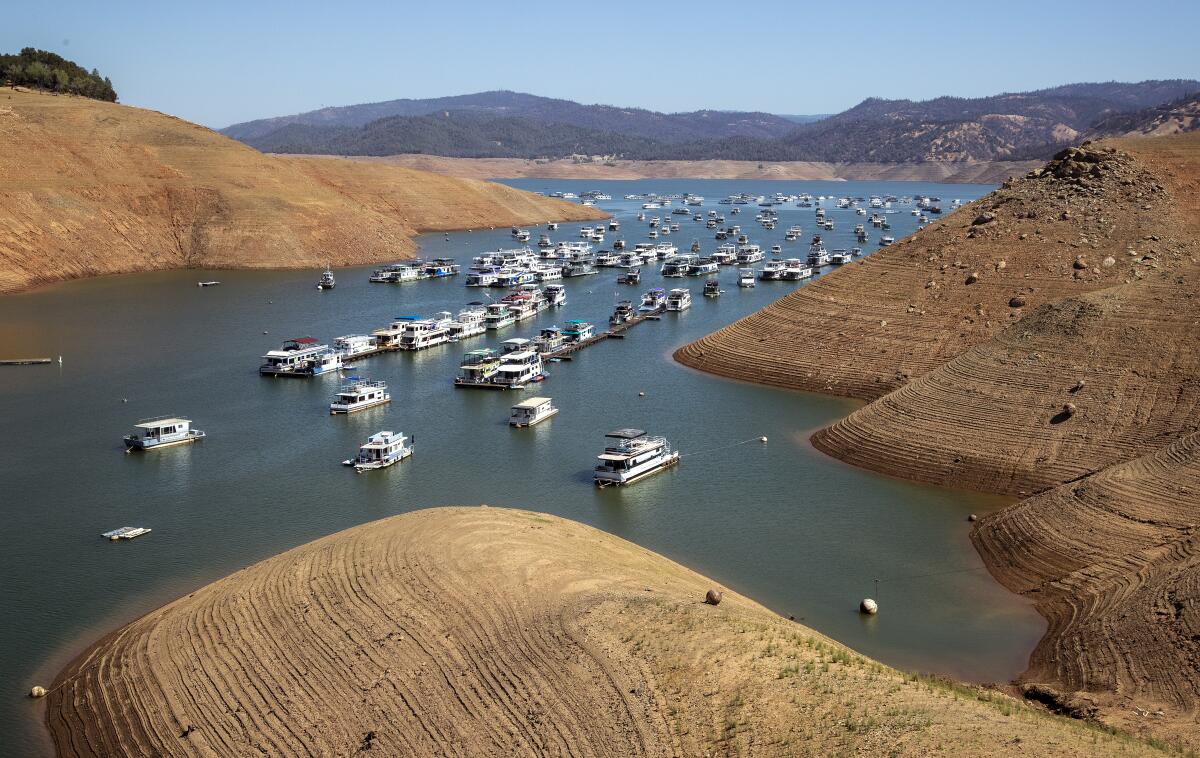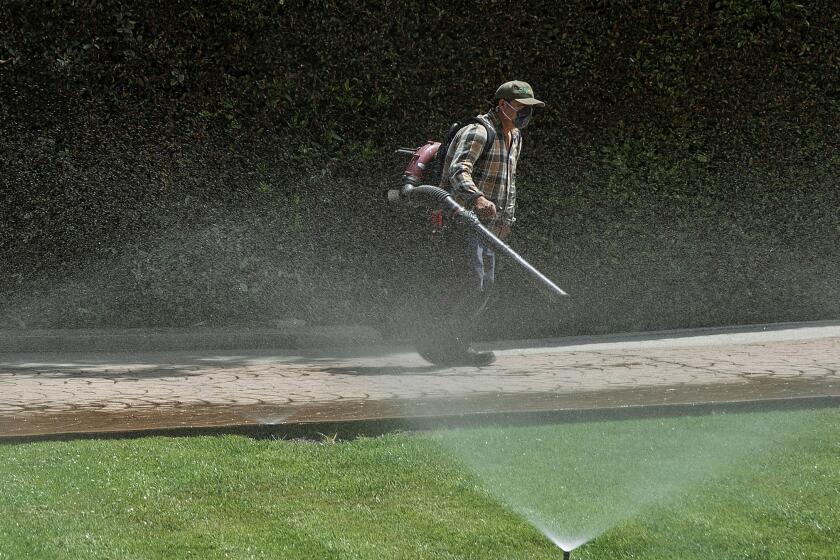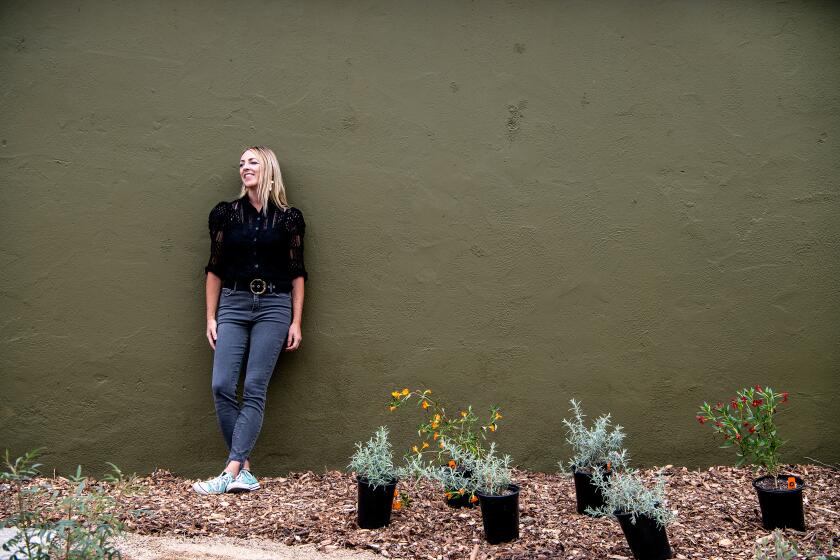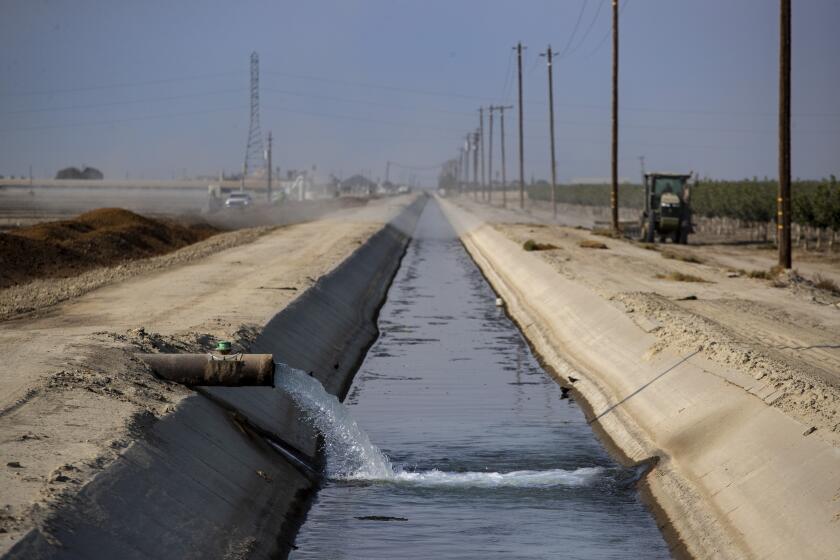California urban water use rose 19% in March despite worsening drought

Despite official calls to increase conservation amid worsening drought, urban water use across California increased by nearly 19% in March, according to the State Water Resources Control Board.
The startling conservation figure was among a number of grim assessments water officials offered reporters Tuesday in a California drought outlook. Others included critically low reservoir levels and major shifts in the water cycle due to climate change.
When compared to March 2020 — the year the current drought began — average water use in cities and towns across the state increased 18.9%, according to the water board.
The increase was even greater in the South Coast Hydrologic Region, which is home to more than half the state’s population. In this region, which includes Los Angeles, urban water use increased 26.9%.
Department officials said the steep increase was due in part to March 2020 being wetter than average when compared to March of this year. The first three months of this year marked the driest start to the calendar year in California history, with statewide precipitation at only 15% of average.
March 2022 was also 3.6 degrees hotter than usual, while the same month one year prior was 1.3 degrees cooler than average.
“It’s almost like apples and oranges, because we did have quite a bit more precipitation in that March versus the one that we experienced here,” said board member Sean Maguire.
Gov. Newsom asked Californians to reduce their water usage by 15% last year. Most places are nowhere near that mark.
Nonetheless, California conservation figures remain far below the voluntary 15% savings that Gov. Gavin Newsom urged last summer. Statewide cumulative water savings from July 1, 2021 to March amounted to just 3.7% relative to a 2020 baseline.
This March also saw the highest statewide “production” — total water use including agricultural — since 2015, according to the water board.
The only region that continued to see water savings is the North Coast region, with a 4.3% decrease in usage. Northern California experienced a drier-than-usual March 2020 and has done the most to conserve since then.
“They were actually one of the first areas to start seeing the warning signs of these increasingly hot and dry conditions,” said Marielle Rhodeiro, a research data specialist for the water board.
The Metropolitan Water District of Southern California recently announced its harshest-ever water restrictions, with the goal of reducing water usage by at least 35%. Under the district’s order, the Los Angeles Department of Water and Power is moving to Phase 3 of its six-phase drought conservation ordinance. Starting June 1, outdoor watering will be limited to twice a week for a maximum of eight minutes.
MWD General Manager Adel Hagekhalil said the numbers reported Tuesday underscore the importance of the district’s drought restrictions and the rules announced by LADWP.
“Conservation is an absolute necessity for the more than 6 million Southern Californians who live in communities that have limited supplies to make it through this year,” Hagekhalil said. “We must do more. Our situation is critical.”
In response to the crisis,Newsom’s office plans to propose $180 million in funding for small water suppliers for infrastructure replacement and immediate drought relief, and grants for urban water management projects in the state budget, in addition to the $120 million from his January budget, a spokesperson for the office said Tuesday.
The revised budget, which will include his full multibillion-dollar drought proposal, will be unveiled on Friday.
The budget will also include $116.8 million for improved forecasting and public education and communication, as well as $216 million for local agencies to fund turf-replacement rebates and for water conservation projects within the state government.
Of those funds dedicated to outreach, $100 million will go toward the state’s Save Our Water public awareness campaign.
Southern California officials have declared a water shortage emergency. Here’s how to keep home and garden dreams alive while still restricting water usage.
During Tuesday’s drought briefing, water officials described a number of dire metrics.
For example, the state’s snowpack — a critical reserve of water going into the summer — peaked in mid-to-late April rather than extending into May, a full month earlier than normal. The annual measurement of water stored in the snowpack on April 1 found the fifth-lowest snowpack since 1950.
During the driest months of the year, snowmelt feeds major reservoirs like Shasta Lake — which is currently at a “critically low” level, officials said. The reservoir is at 47% of its historical average.
“This is what we have, this is what we’re going to get. We can’t expect anything significant past this,” said Jeanine Jones, manager of interstate resources at the Department of Water Resources.
In the Colorado River Basin, which has been in a long-term drought since 2000, the two largest reservoirs in the nation — Lake Mead and Lake Powell — are at all-time lows. Federal projections show they will continue to decline in coming months.
“This is really an indication that Mother Nature is reminding us that we are in a world with climate change. It’s here, and we need to start adapting to it,” Jones said.









